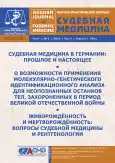Математическое моделирование погрешностей определения давности наступления смерти на основе закона охлаждения Ньютона–Рихмана
- Авторы: Недугов Г.В.1
-
Учреждения:
- Самарский государственный медицинский университет
- Выпуск: Том 7, № 2 (2021)
- Страницы: 88-95
- Раздел: Оригинальные исследования
- URL: https://journals.rcsi.science/2411-8729/article/view/122404
- DOI: https://doi.org/10.17816/fm373
- ID: 122404
Цитировать
Полный текст
Аннотация
Актуальность. Обязательным элементом разработки и внедрения диагностических технологий определения давности наступления смерти тепловым методом является оценка их возможных погрешностей. Для уравнений охлаждения трупа, имеющих детерминистский характер, оценка погрешностей возможна на основе математической модели косвенного измерения. В настоящей статье предложена математическая модель оценки предельных абсолютных погрешностей определения давности наступления смерти на основе закона охлаждения Ньютона–Рихмана в условиях постоянной и изменяющейся температуры внешней среды. Цель исследования — разработать метод оценки погрешностей определения давности наступления смерти на основе закона охлаждения Ньютона–Рихмана с учетом математической модели косвенного измерения. Материал и методы. Осуществлено математическое моделирование погрешностей определения давности наступления смерти в условиях постоянной и изменяющейся температуры окружающей среды на базе закона Ньютона–Рихмана. Код программы для электронно-вычислительной машины написан на языке программирования C# с использованием приложения Microsoft Visual Studio 2019. Результаты. На основе модели косвенного измерения разработан метод оценки предельных абсолютных погрешностей определения давности наступления смерти при охлаждении по закону Ньютона–Рихмана в условиях постоянной и изменяющейся температуры внешней среды. Разработанная математическая модель реализована в формате прикладной программы Warm Bodies NRN. Полученные результаты позволяют осуществлять аналитическое определение погрешностей установления давности наступления смерти в раннем посмертном периоде. Заключение. Разработанный метод целесообразно использовать в судебно-медицинской экспертной практике при определении давности наступления смерти.
Полный текст
Открыть статью на сайте журналаОб авторах
Герман Владимирович Недугов
Самарский государственный медицинский университет
Автор, ответственный за переписку.
Email: nedugovh@mail.ru
ORCID iD: 0000-0002-7380-3766
SPIN-код: 3828-8091
Scopus Author ID: 25947646500
ResearcherId: ABH-5590-2020
к.м.н., доцент кафедры судебной медицины
Россия, 443099, Самара, ул. Чапаевская, д. 89Список литературы
- Kanawaku Y., Kanetake J., Komiya A., et al. Effects of rounding errors on postmortem temperature measurements caused by thermometer resolution // Int J Legal Med. 2007. Vol. 121, N 4. P. 267–273. doi: 10.1007/s00414-006-0088-8
- Verica P., Janeska B., Gutevska A., Duma A. Post mortem cooling of the body and estimation of time since death // Soud Lek. 2007. Vol. 52, N 4. P. 50–56.
- Вавилов А.Ю., Халиков А.А. О минимизации ошибок термометрического метода определения давности смерти // Проблемы экспертизы в медицине. 2009. Т. 9, № 1. С. 11–14.
- Henssge C. Rectal temperature time of death nomogram: dependence of corrective factors on the body weight under stronger thermic insulation conditions // Forensic Sci Int. 1992. Vol. 54, N 1. Р. 51–66. doi: 10.1016/0379-0738(92)90080-g
- Hubig M., Muggenthaler H., Sinicina I., Mall G. Body mass and corrective factor: impact on temperature-based death time estimation // Int J Legal Med. 2011. Vol. 125, N 3. P. 437–444. doi: 10.1007/s00414-011-0551-z
- Тейлор Д. Введение в теорию ошибок. Пер. с англ. Москва: Мир, 1985.
- Недугов Г.В. Математическое моделирование охлаждения трупа в условиях изменяющейся температуры окружающей среды // Судебная медицина. 2021. Т. 7, № 1. С. 29–35. doi: 10.17816/fm360
- Rainy H. On the cooling of dead bodies as indicating the length of time that has elapsed since death // Glasgow Med J. 1869. Vol. 1, N 3. Р. 323–330.
- Ganio M.S., Brown C.M., Casa D.J., et al. Validity and reliability of devices that assess body temperature during indoor exercise in the heat // J Athl Train. 2009. Vol. 44, N 2. Р. 124–135. doi: 10.4085/1062-6050-44.2.124
Дополнительные файлы







